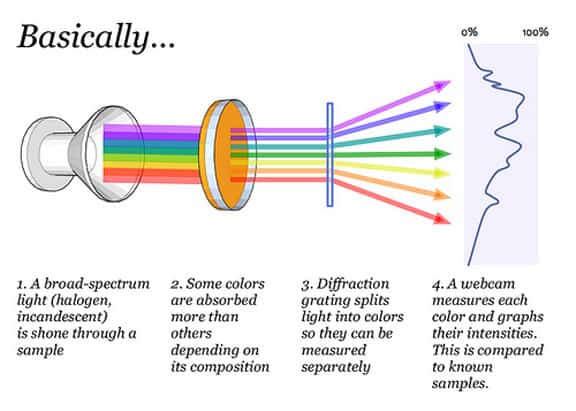![]() Michael Seeliger (Brooklyn, Wisconsin) has been periodically updating me with his progress on his work for a color spectrophotometer for use in determining the color for a particular bottle. This is really cutting edge work for our hobby. I included one of his historical e-mails below plus a hand-out he distributed at the recent Mansfield Bottle Show. He also has an article planned for the July issue of Antique Bottle & Glass Collector.
Michael Seeliger (Brooklyn, Wisconsin) has been periodically updating me with his progress on his work for a color spectrophotometer for use in determining the color for a particular bottle. This is really cutting edge work for our hobby. I included one of his historical e-mails below plus a hand-out he distributed at the recent Mansfield Bottle Show. He also has an article planned for the July issue of Antique Bottle & Glass Collector.
Ferd,
I just spoke to my guy who will make a spectrophotometer to measure glass color. He will have it to me by the 19th so I can play around with it either with Bill Mitchell, maybe go over to Jeff Burkhardts and then take it to St Pete with me to see what Jim Mitchell has to say and some of the auction guys there. According to Ted (guy who is making it) it will consist of a tungsten lamp placed inside the bottle and a spect. about the size of a cigarette package placed against the side of the bottle. The color will be given in terms of rbg.
I plan on trying several bottles, taking pictures, deciding which bottles look the same color and see if they show up with the same readings. Then see what changes in readings constitute a change in color perception in the eye of the beholder. Determine changes in color in the same bottle (bottom to top). Possible changes due to thickness etc. etc. just to see if it is at all measurable.
Ted feels this is just a prototype and we can see how it works and perfect it if it does. If it does work and I go to enough collectors and certify color on enough bottles maybe we have something.
Again it will work on a tungsten lamp although we can try other light sources if that doesn’t work. It would be run by a usb attachment to a lap top. You would start by measuring specific known color discs just to make sure your calibration zero is working. Then measure the bottles etc and then measure the discs again to see that the results aren’t shifting. Ted thinks the final unit would cost around $5000. Don’t know about upkeep. If it works, it looks like a business opportunity or perhaps selling some units to the larger shows or renting it out, or maybe having people send bottles in for testing. I don’t know exactly how it would work but it might be really cool. We’d have to have a kind of a book that would have color shades defined in terms of rgb equivalents vs color names just to allow us to talk about a color scale. Maybe glass samples from stained glass to determine color definitions???? it would have to have the backing of the Federation or at least a lot of the big collectors who value color.
Just a few thoughts to keep you in the loop on what is going on here.
I cc’d Bill Taylor and Bill Mitchell because I have been talking to them about this also and I value their ideas.
Michael Seeliger
Read More on Color:
The Color Yellow – A wide range of shades
The Color Purple or Amethyst in Antique Glass
What is Puce or ‘Pooce’ as some call it?
Not Brown – A “chocolate” Brown’s Celebrated Indian Herb Bitters


















Saw @Mansfield show. With all due respect to Mike’s work, conversation that followed between other dealer/collectors and I boiled down to: We will never buy or collect an objective number; we will forever buy a subjective “eye of overall coloration” and perhaps a fancy adjective to go with it.
The imprecise nature of early glass making evident in so many killer pieces, shows that often they are MANY colors that can vary in shade and intensity within a single piece. Mike’s experience with the “chameleon” of all bottles, the GREELEY’S BARREL, bears this out. This of course demands actually SEEING the piece in various and changing lighting. That all said, Mike’s I.D. # for a particular shade of puce, for example, may have value as a starting point of description.
Would be very interesting to know if this might be a useful tool for attribution of bottles to particular glass works, and / or regions?
If it could work in that way it would require a lot of preliminary work, but maybe it could clear up a lot of the uncertainty about origins of many items. Not just within the US, but also at even larger scales: between different sides of the Atlantic (British vs US origin).
On that subject, keep an eye out for the next issue of the Journal of Glass Studies, due out later this year.